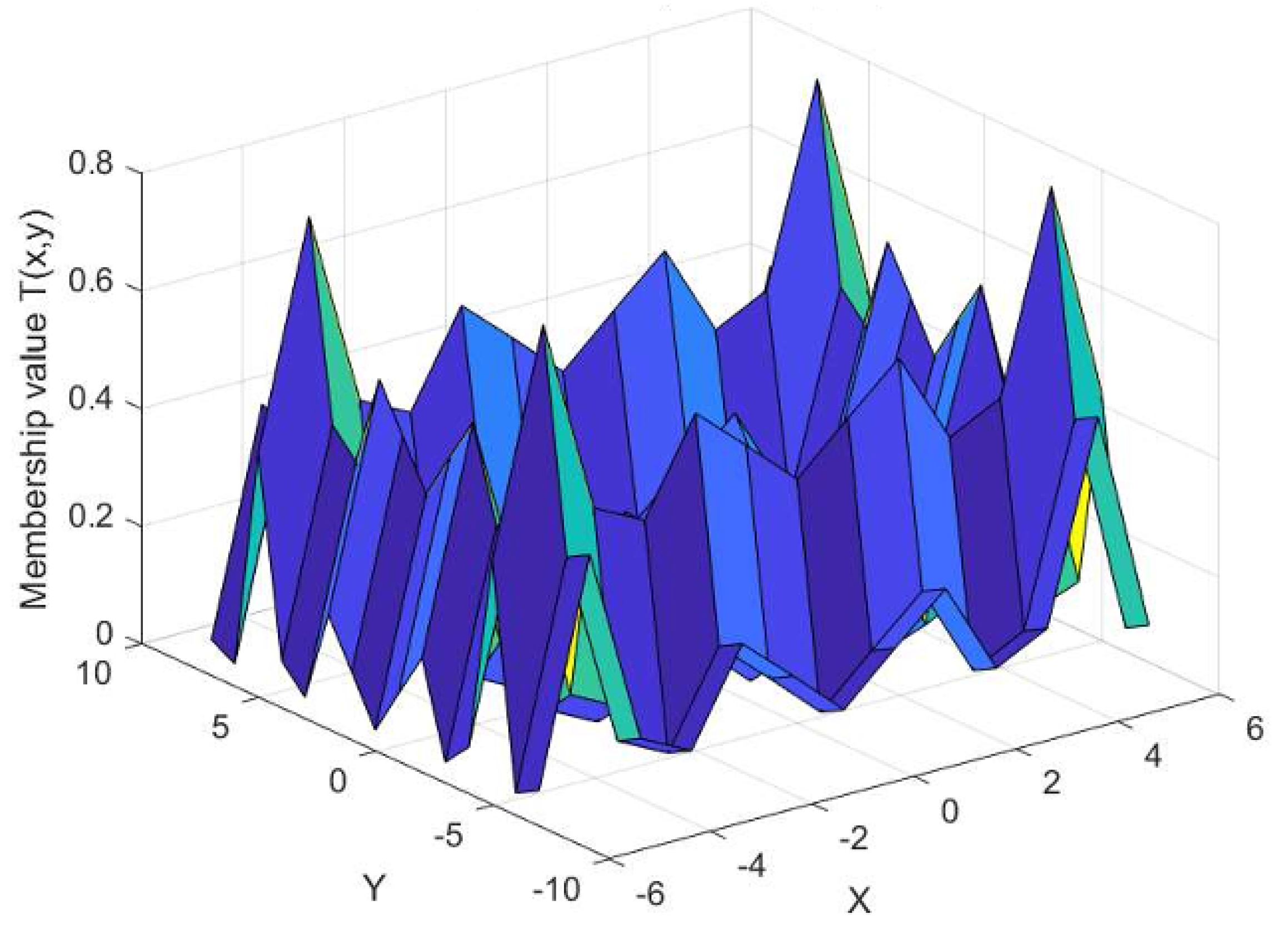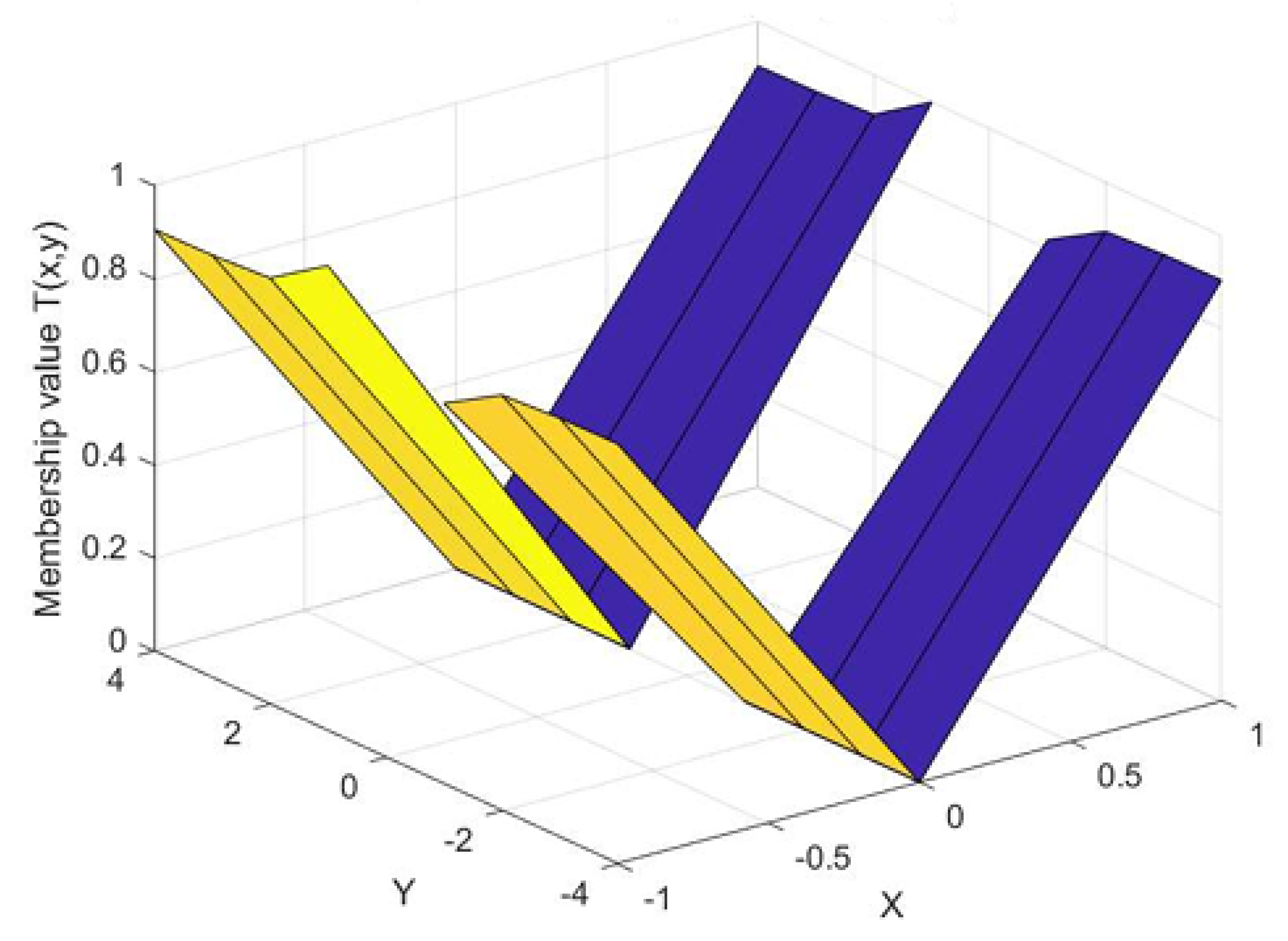A Study on the Existence of Fixed Point Results for Some Fuzzy Contractions in Fuzzy Metric Spaces with Application
Abstract
1. Introduction
2. Preliminaries
- (1)
- Symmetry:
- (2)
- Monotonicity: and
- (3)
- Associativity:
- (4)
- Boundary conditions:
- (1)
- Lukasiewicz t-norm: =
- (2)
- Product t-norm: =
- (3)
- Minimum t-norm: that is, =
- (ℓ1)
- (ℓ2)
- ) =1 iff
- (ℓ3)
- =
- (ℓ4)
- (ℓ5)
- is continuous.
- Define as = for all and ; then, is a fuzzy metric space on Δ with the product t-norm ∗.
- = min
- where A, B and .
3. Fuzzy-Fixed-Points for Fuzzy Contractions
3.1. Applications
4. Conclusions
Author Contributions
Funding
Data Availability Statement
Acknowledgments
Conflicts of Interest
Abbreviations
| The collection of all compact subsets in the fuzzy metric space . | |
| The collection of all fuzzy sets in . | |
| All positive real numbers. | |
| Set of natural numbers. | |
| Set of real numbers. |
References
- Zadeh, L.A. Fuzzy sets. Inf. Control. 1965, 8, 338–353. [Google Scholar] [CrossRef]
- Jafari, S. Research on Fuzzy Logic and Mathematics with Applications. Symmetry 2024, 16, 1684. [Google Scholar] [CrossRef]
- Tassaddiq, A.; Kanwal, S.; Perveen, S.; Srivastava, R. Fixed points of single-valued and multi-valued mappings in sb-metric spaces. J. Inequalities Appl. 2022, 2022, 85. [Google Scholar] [CrossRef]
- Tassaddiq, A. General escape criteria for the generation of fractals in extended Jungck—Noor orbit. Math. Comput. Simul. 2022, 196, 1–14. [Google Scholar] [CrossRef]
- Tassaddiq, A.; Shabbir, M.S.; Din, Q.; Naaz, H. Discretization, bifurcation, and control for a class of predator-prey interactions. Fractal Fract. 2022, 6, 31. [Google Scholar] [CrossRef]
- Kramosil, I.; Michalek, J. Fuzzy metrics and statistical metric spaces. Kybernetika 1975, 11, 336–344. [Google Scholar]
- George, A.; Veeramani, P. On some results in fuzzy metric spaces. Fuzzy Sets Syst. 1994, 64, 395–399. [Google Scholar] [CrossRef]
- Grabiec, M. Fixed points in fuzzy metric spaces. Fuzzy Sets Syst. 1988, 27, 385–389. [Google Scholar] [CrossRef]
- Ahmed, M.A. Fixed point theorems in fuzzy metric spaces. J. Egypt. Math. Soc. 2014, 22, 59–62. [Google Scholar] [CrossRef]
- Ali, B.; Abbas, M. Fixed point theorems for multivalued contractive mappings in fuzzy metric spaces. Am. J. Appl. Math. 2015, 3, 41–45. [Google Scholar] [CrossRef]
- Azam, A.; Kanwal, S. Common fixed point results for multivalued mappings in Hausdorff intuitionistic fuzzy metric spaces. Commun. Math. Appl. 2018, 9, 63–75. [Google Scholar]
- Ashraf, M.S.; Ali, R.; Hussain, N. Geraghty Type Contractions in Fuzzy b-metric Spaces with Application to Integral Equations. Filomat 2020, 34, 3083–3098. [Google Scholar] [CrossRef]
- Ashraf, M.S.; Ali, R.; Hussain, N. New fuzzy-fixed-point Results in Generalized Fuzzy Metric Spaces with Application to Integral Equations. IEEE Access 2020, 8, 91653–91660. [Google Scholar] [CrossRef]
- Kanwal, S.; Kattan, D.; Perveen, S.; Islam, S.; Shagari, M.S. Existence of fixed points in fuzzy strong b-metric spaces. Math. Probl. Eng. 2022, 2022, 1–9. [Google Scholar] [CrossRef]
- Kanwal, S.; Ali, A.; Al Mazrooei, A.; Santos-Garcia, G. Existence of fuzzy-fixed-points of set-valued fuzzy-mappings in metric and fuzzy metric spaces. AIMS Math. 2023, 8, 10095–10112. [Google Scholar] [CrossRef]
- Gregori, V.; Miñana, J.; Roig, B.; Sapena, A. On Completeness and Fixed Point Theorems in Fuzzy Metric Spaces. Mathematics 2024, 12, 287. [Google Scholar] [CrossRef]
- Razani, A. A contraction theorem in fuzzy metric spaces. Fixed Point Theory Appl. 2005, 2005, 1–9. [Google Scholar] [CrossRef]
- Wardowski, D. Fuzzy contractive mappings and fixed points in fuzzy metric spaces. Fuzzy Sets Syst. 2013, 222, 108–114. [Google Scholar] [CrossRef]
- Shamas, I.; Rehman, S.U.; Aydi, H.; Mahmood, T.; Ameer, E. Unique fixed-point results in fuzzy metric spaces with an application to Fredholm integral equations. J. Funct. Spaces 2021, 2021, 1–12. [Google Scholar] [CrossRef]
- Rodriguez-Lopez, J.; Romaguera, S. The Hausdorff fuzzy metric on compact sets. Fuzzy Sets Syst. 2004, 147, 273–283. [Google Scholar] [CrossRef]
- Heilpern, S. Fuzzy-mappings and fixed point theorem. J. Math. Anal. Appl. 1981, 83, 566–569. [Google Scholar] [CrossRef]
- Nadler, S.B., Jr. Multi-valued contraction mappings. Pac. J. Math. 1969, 30, 475–488. [Google Scholar] [CrossRef]
- Shagari, M.S.; Azam, A. Fixed point theorems of fuzzy set-valued maps with applications. Probl. Anal. 2020, 9, 68–86. [Google Scholar]
- Shahzad, A.; Shoaib, A.; Mlaiki, N.; Aiadi, S.S. Results for fuzzy-mappings and Stability of Fuzzy Sets with Applications. Fractal Fract. 2022, 6, 556. [Google Scholar] [CrossRef]
- Ramos de Andrade, A.E.; Wasques, V.F. Fixed-Point Theorems for fuzzy-mappings. Mathematics 2024, 12, 2165. [Google Scholar] [CrossRef]
- Kannan, R. Some results on fixed points. Bull. Calcutta Math. Soc. 1968, 60, 71–76. [Google Scholar]
- Phiangsungnoen, S.; Sintunavarat, W.; Kumam, P. Fuzzy-fixed-point theorems in Hausdorff fuzzy metric spaces. J. Inequalities Appl. 2014, 2014, 201. [Google Scholar] [CrossRef]
- Senthilraj, S.; Saravanakumar, T.; Raja, R.; Alzabut, J. Delay-dependent passivity analysis of nondeterministic genetic regulatory networks with leakage and distributed delays against impulsive perturbations. Adv. Differ. Equ. 2021, 2021, 1–26. [Google Scholar] [CrossRef]
- Tassaddiq, A.; Tanveer, M.; Usman, M.; Almutairi, D.K.; Alharabi, R. On the Global Dynamics of a Fourth-Order Riccati-Type Exponential Fuzzy Difference Equation. Axioms 2025, 14, 118. [Google Scholar] [CrossRef]
- Kaur, S.; Özkan, A.; Alanazi, F.D. A new perspective on fuzzy-mapping theory with invertedly open and closed mappings. AIMS Math. 2025, 10, 921–931. [Google Scholar] [CrossRef]



Disclaimer/Publisher’s Note: The statements, opinions and data contained in all publications are solely those of the individual author(s) and contributor(s) and not of MDPI and/or the editor(s). MDPI and/or the editor(s) disclaim responsibility for any injury to people or property resulting from any ideas, methods, instructions or products referred to in the content. |
© 2025 by the authors. Licensee MDPI, Basel, Switzerland. This article is an open access article distributed under the terms and conditions of the Creative Commons Attribution (CC BY) license (https://creativecommons.org/licenses/by/4.0/).
Share and Cite
Tassaddiq, A.; Kanwal, S.; Rasheed, F.; Almutairi, D.K. A Study on the Existence of Fixed Point Results for Some Fuzzy Contractions in Fuzzy Metric Spaces with Application. Axioms 2025, 14, 132. https://doi.org/10.3390/axioms14020132
Tassaddiq A, Kanwal S, Rasheed F, Almutairi DK. A Study on the Existence of Fixed Point Results for Some Fuzzy Contractions in Fuzzy Metric Spaces with Application. Axioms. 2025; 14(2):132. https://doi.org/10.3390/axioms14020132
Chicago/Turabian StyleTassaddiq, Asifa, Shazia Kanwal, Faisal Rasheed, and Dalal Khalid Almutairi. 2025. "A Study on the Existence of Fixed Point Results for Some Fuzzy Contractions in Fuzzy Metric Spaces with Application" Axioms 14, no. 2: 132. https://doi.org/10.3390/axioms14020132
APA StyleTassaddiq, A., Kanwal, S., Rasheed, F., & Almutairi, D. K. (2025). A Study on the Existence of Fixed Point Results for Some Fuzzy Contractions in Fuzzy Metric Spaces with Application. Axioms, 14(2), 132. https://doi.org/10.3390/axioms14020132





